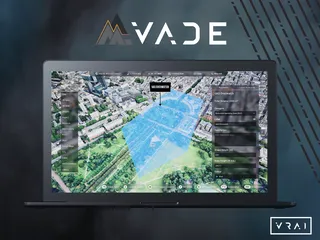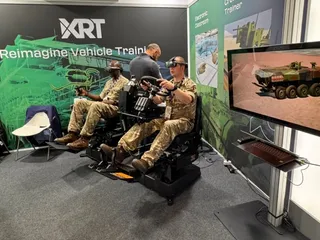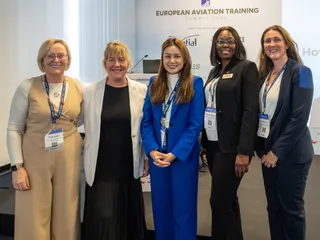How To: BeEmotion.ai builds AeroMind - Hunches to Evidence: Objective Emotional Analytics in Flight Training
Contact Our Team
For more information about how Halldale can add value to your marketing and promotional campaigns or to discuss event exhibitor and sponsorship opportunities, contact our team to find out more
The Americas -
holly.foster@halldale.com
Rest of World -
jeremy@halldale.com
.jpg/r%5Bwidth%5D=320/bb3e66a0-7f9c-11f0-b736-478260ce7873-CAT%20Marty%20feature%201_AeroMind_APS_MCC_training_session%20(1).webp)
Halldale Group monitors and comments on technology, collaborative and other developments in civil aviation, defense and safety critical industries’ training enterprises. It’s time to tie the pieces together.
This is the first in a series of articles that highlights how an industry-training enterprise team has implemented learning (training and education) programs across safety-critical communities – a “how to” perspective, if you will. These articles will provide lessons learned, challenges, ROIs, best practices and other highlights of randomly selected programs fielded in these training organizations. After exploring several programs, we will provide commonalities – the “good” and the “bad” among the technology-enabled use cases.
Focused, Compressed Timeline to Test Deployment
This January 2025, a press release from BeEmotion.ai, a provider of AI and human behavior technology solutions focused on preventing accidents and other improvements in high-risk industries, caught my attention. The document highlighted the partners’ test deployment of their AI software tool to support the coaching of aspiring commercial airline pilots at Simnest Pilot Academy (SPA) which supplies pilots for a number of European-based airlines.
Remember the month of the press release as it provides another instance of the speed that small, agile, technology companies typically explore collaborative opportunities and move their ideas to reality. Chris Makai, Founder of AviatePro Services, who had an idea about making objective measurements of the emotions of pilots in simulators, recalled that in early 2024, BeEmotion.ai (formerly nViso) had hosted his team at their R&D center in Switzerland. The executive continued, “The company’s Head of Product, Bogdan Lazar, and the whole company, showed the openness and practical mindset that made collaboration possible.” Significantly it was five months from concept to test deployment. It’s worth noting that BeEmotion.ai had spent 10+ years on development of their patented AI human behavior analytics engine.
Another key, early takeaway from the supplier-customer relationship was the Budapest-based SPAs “openness” to AeroMind. Whereas Halldale Group typically reports both private and public sector organizations embrace of learning new technologies for diverse reasons – from curtailing surges in workplace accidents to reducing upticks in training costs – Makai recalled, at Simnest Pilot Academy there were no instructional shortcomings. Their interest stemmed from a proactive, innovation-focused mindset. “Industry-wide, however, there’s recognition that certain human factors such as stress management and decision-making under pressure deserve greater emphasis.” the executive explained and added, “Simnest’s director is committed to continuous improvement and adopting cutting-edge tools, and AeroMind offers a unique, objective, non-intrusive diagnostic tool to support this mission.”
Platform Highlights
The AeroMind system runs inside the simulator, capturing over 300 metrics per second on micro-expressions, gaze, posture. Within minutes, it generates objective reports for both instructors and pilots. Captains and first officers can now monitor their own behaviors and compare reactions to their peers across a growing database. Instructors gain a quantified view of performance instead of relying solely on intuition, with evidence of resilience and recovery times mapped directly to CBTA and EBT observable behaviors. Airlines benefit by using this data to grow their training programs. Trends across fleets and bases show where pilots need targeted support, helping standardize quality and reduce overall risk.
AeroMind validates workflows such as “Recognize, Confirm, Breathe’’ by showing how quickly a pilot regains focus after startle or fatigue events. With AeroMind, training moves from subjective notes to data-driven insight helping to building more resilient captains and first officers, and safer operations across the airline.
In test deployment AeroMind remains a “living system” with BeEmotion regularly updating models using context-specific simulator data. Guardrails are explicit with on-premises processing, no automated scoring and human-in-the-loop. The aim is not to replace instructors but to enrich judgement with measurement-based facts, supporting the shift from pure selection to selection-and-development by identifying coachable gaps and guiding targeted training.
Roadmap to Establish the AeroMind Platform
One of the glaring understatements the author will use in this article is the rate of AI development for high-risk community learning is “gaining speed.” As noted in our AI podcast program and in our departments’ content, it is more accurate to say this technology space is advancing at a torrid pace. Against this reality is the imperative to look at other parts of AeroMind AI platform’s foundation as there are differentiators setting it apart from like products in the civil aviation training space. What should emerge from a review of the build of the product is how the team has integrated data, a non-intrusive architecture and other underpinnings with a focus on allowing human coaches, flight instructors and ATOs to better support their cadets.
Makai then highlighted in more detail other significant AeroMind capabilities:
- Non-intrusive data capture: No connection to the simulator computer. Using a camera and AI, the platform tracks 300+ points per frame per person - real-time emotional state, body posture, gaze and hand position;
- Instructor value from day one: automatic master warning/caution detection allows two-click replay of critical moments, showing exactly what happened and how the cadet’s emotional state changed; and
- Ease of use: Designed to support, not burden, instructors - providing factual, measurement-based data such as crew resource management balance or recovery time after a startle.
In with the Instructor-Coach
The role of the instructor-coach is another important departure point in the “how to” build strategy of the BeEmotion.ai/AviatePro Services/SPA project when compared to other AI-based strategies.
Enablement at SPA was light-touch. AeroMind surfaces objective, event-aligned markers that map directly to how instructors already debrief, so most needed only a short onboarding to use it confidently. The system never replaces judgement or issues scores – it corroborates what instructors sense and makes those moments easy to find and discuss. A continuous feedback loop with the instructors refines features without disrupting existing practice.
ROIs
There are early ROIs to report from the test of the AeroMind AI software tool used on the A320-based FNPT II MCC flight simulators delivered by Simnest Aviation – perhaps further motivating other high-risk training enterprises to integrate AI in their programs. While Makai emphasized that it is early for clarifying the full financial ROI, value is emerging in different key areas:
- Sharper diagnostics and consistency. Baseline-relative, event-aligned markers accelerate instructor focus on salient behaviors, support CBTA-aligned debriefs, improve inter-rater consistency and reduce debrief prep. Trainees receive clear, evidence-based feedback grounded in objective timelines;
- Shorter remediation cycles for trainees. Timely, objective self-awareness and targeted practice reduce unproductive iteration between sessions and may shorten the path to airline readiness; and
- Earlier support for experienced pilots. Trend-aware timelines against personal baselines help instructors spot meaningful deviations across checks and open proactive conversations before issues escalate.
Decision-Support Aid
AeroMind is used solely as a debrief decision-support aid; it does not reduce or substitute any required training, checking or experience, and, subject to competent-authority acceptance, it does not alter the FSTD’s qualification basis or the approved syllabus. EASA: ORA.FSTD.230 / CS-FSTD(A) Issue 2. UK: CAA SD-18. US: 14 CFR Part 60 (§60.23). Australia (CASA): CASR Part 60 MOS.
Challenges
While the AeroMind AI software tool is providing early ROIs noted earlier and other positive outcomes, Makai also addressed some early challenges on the road to build-up and implementation.
Data at scale - opportunity and discipline. Paradoxically, the biggest challenge stems from the system’s strength. As datasets grow, emergent patterns multiply - not only for individuals but across entire crews. Processing and interpreting this responsibly is a continuous task that demands constant refinement and instructor feedback.
Makai also recalled often-asked questions about AeroMind: “Can I benchmark my resilience against peers during LPC?”; “Can you quantify emotional recovery (e.g. after a master warning) dynamics across cohorts (e.g. experience levels)?” and “Can you flag indicators of attentional narrowing (‘tunnel vision’)?”
The AeroMind team’s approach is clear – they do not publish person-to-person league tables or automated rankings. All outputs are baseline-relative and designed for coaching/human-factor development. Any cohort analysis is anonymized and ethics-governed – they do not make generalizations about protected attributes. Where relevant, the system surfaces evidence-based indicators, e.g. changes in gaze dispersion or response latency strictly for instructor review with humans firmly in the loop.
Not for Civil Aviation Only
As noted in many articles across the three Halldale verticals, underpinning technologies (digital twin, XR, data analytics and others) are commonly used across training organizations. Of no surprise, Makai told the author the AeroMind AI software is designed for similar use cases in other high-stress professions. He explained, “Our goal is to provide a more accurate picture of what professionals experience, enabling more personalized development and earlier detection of strain,” and significantly added, “We can imagine applications in training programs for air traffic control staff, train operators, shipping professionals and other similar fields.”
AeroMind in Action
APATS 2025 attendees are invited to visit the BeEmotion.ai and AviatePro Services team at Booth T03 and see the platform in action. This will be the civil aviation community’s initial opportunity to view AeroMind at a public event.
[Author’s note: one AeroMind scenario may be viewed below]


